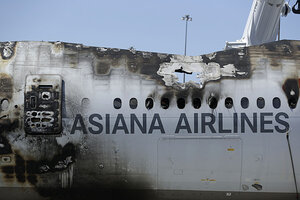Asiana Airlines: Some passengers face long odds for compensation
Because of international regulations, passengers aboard the Asiana Airlines flight that crashed in San Francisco on July 6, 2013 could receive drastically different amounts of monetary compensation from Asiana Airlines — even if they were sitting right next to one another, an attorney says.

The wreckage of Asiana Flight 214, which crashed on July 6, 2013, lies at the San Francisco International Airport on July 12, 2013. Three teenagers were killed and more than 180 people were injured in the air accident, which could spawn dozens of lawsuits from passengers and families.
Jeff Chiu/AP
As federal investigators probe Asiana Airlines for its role in the San Francisco plane crash that killed three teenagers, passengers may find themselves flummoxed. Depending on their nationality and what type of ticket they bought, passengers stand to receive millions of dollars in compensation — or nothing at all.
“You could have two sisters sitting right next to each other on the plane, suffering the exact same injury, and one could be compensated while the other gets nothing,” says Mike Danko, an aviation attorney and pilot based in San Francisco. “The fortuity of where your ticket ends could change everything, and nobody has any idea of that when they book a flight."
The dramatic discrepancy in payouts is due to an international treaty called the Montreal Convention, which limits air disaster victims to filing lawsuits in their home country, their final destination, or the country the air carrier is based in. Under the treaty, many of the more than 200 non-Americans who were aboard Flight 214 will be forced to file their complaints outside the US — where courts typically award plaintiffs much less than their American counterparts.
“As a practical matter, there aren’t suits in other countries. Generally, the amounts that you can recover in other countries are so small that it doesn’t even make sense to sue,” Mr. Danko says.
That means a Chinese passenger who had a one-way ticket to San Francisco could recover millions of dollars for a serious injury, while another Chinese passenger with a round-trip ticket back to China could get nothing.
That's exactly what happened in 1997. After a Korean Air plane crashed in Guam, killing 228 people aboard, families who sued the airline in Korea were awarded $626,500; families who sued in a US court were awarded $1,790,000, according to The Chosun Ilbo, a major daily newspaper in South Korea.
With costly stakes resting on where lawsuits will be lodged, Asiana’s top priority is to figure out how to keep as many cases as possible out of US courts, Danko says.
“If the bulk of the cases stay in the US, $100 million [in damages] is not out of the question. But if the majority of cases aren’t allowed to be brought in the US … you’re talking far, far less,” he says.
Asiana will also likely be trying to quash as many cases as possible over the next few weeks, according to Danko. Under federal law, lawyers are prohibited from contacting victims of an air accident for 45 days after the crash. Typically, air carriers use the time to approach passengers, make amends, and reach a settlement — often for a significantly smaller sum than a plaintiff would have won in court.
“I imagine that by the time the 45-day period ends, Asiana will have resolved claims cheaply,” Danko says.
For passengers who do pursue litigation, Asiana is obligated to pay up to $148,000 to each person who was on board Flight 214, regardless of what caused the plane to crash. Passengers can claim even more than that if Asiana is unable to prove it did nothing wrong — a scenario that could unfold depending on the results of an ongoing federal investigation.
Although it has yet to reach a full conclusion, the National Transportation Safety Board (the body investigating the accident) has already hinted at the possibility of pilot error playing a role in the crash. Asiana’s plane was moving dangerously slowly and low as it approached the runway, NTSB Chairwoman Deborah Hersman said in a news conference Thursday.
Experts estimate that the accident will cost millions.
Asiana’s insurers are expected to pay $44.5 million in damages to passengers and the City of San Francisco, estimates the Financial Services Commission, South Korea’s top financial regulator. They are expected to pay another $131 million to replace the Boeing 777 that was all but destroyed after the July 6 crash.
In the meantime, Asiana is busy pursuing a lawsuit of its own. The airline announced Monday that it would sue a San Francisco news station that mistakenly broadcasted fake, racially offensive names of Asiana pilots.

